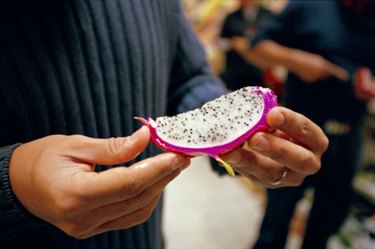
Dragon fruit plants are native to Central America, South America and Mexico. They were brought to Vietnam in the early 19th century by the French, and they are now grown in other parts of the world, including the United States. In the United States, dragon fruit can grow outdoors in USDA plant hardiness zones 9 through 11. States in this southern zone include Florida, California and Texas. What about other regions, though? Can you grow dragon fruit plants in Arizona?
Growing Dragon Fruit Trees in Arizona
Video of the Day
Arizona planting zones range from 4b to 10b. The state's capital, Phoenix, is in the south-central part of Arizona, and it falls in USDA planting zone 9b. Growing dragon fruit in Phoenix is possible as long as it is planted and cared for properly. Should temperatures plummet, these plants will need to be protected from frost.
Video of the Day
Arizona's climate is arid to semiarid, and residents experience extreme heat, mild winters and other temperatures outside that range at various points in time. Areas with higher elevation have colder winters and milder summers. Precipitation is also varied based on the specific location, ranging from 3 to 40 inches of annual rain.
Gardening can be complicated in Arizona unless you know the planting zone in which you live and how to approach it. The state's hot, dry climate in the central part of the state is conducive for growing sunflowers, prickly pear and desert willow. You can also grow radishes, beets and cabbage in the cooler seasons and tomatoes, eggplant and peppers in warm and hot weather.
Growing Dragon Fruit Plants in Arizona
To grow a dragon fruit plant from seed, you can buy seeds from a garden supply company. You can also use a fruit and harvest your own seeds. Slice one dragon fruit in half, scrape out some seeds and rinse them (it is OK to leave some attached pulp). Fill up a small pot with cactus soil mix and add enough water to moisten it. Then, mix the seeds into the top 1/4 inch of the soil and cover the pot with plastic wrap.
Put the pot in a sunny window or beneath grow lights and keep the room temperature warm. Water when needed and you should see sprouts before a month is up. You can thin out the seedlings and prepare to plant one or more outdoors. They can grow in most well-draining soils but do best when the soil is sandy and slightly acidic, preferably with a pH level from 6 to 7.
Dragon fruit plants need at least six hours of full sun per day, and the optimal growth temperature is between 65 and 80 degrees Fahrenheit. These cactus plants should only be watered when the top of the soil feels dry. If the soil gets soaked, the dragon fruit plant will suffer. They can be fertilized about once a month during the growing season but avoid doing so in the winter.
Is Dragon Fruit Edible?
Dragon fruit is certainly edible, and it is tasty and nutritious as well. It has a bright pink (or purple or yellow), green-scaled skin on the outside and white flesh and little black seeds within. This "psychedelic artichoke" appearance can put off some people, but this fruit is full of fiber, iron, carotenoids, vitamin C, lycopene and magnesium.
Experts recommend eating it raw, but it can also be grilled. Some describe its taste as somewhere between a pear and a kiwi – not too sweet and not too tart. You can cut it up and add it to salads, desserts, smoothies and cocktails. If you like fish, dragon fruit goes especially well with mahi-mahi, tuna and cod.
- Blue Book Services: Dragon Fruit
- The Old Farmer's Almanac: What Are Plant Hardiness Zones?
- Gilmour: Arizona Planting Zones
- HGTV: How to Grow Dragon Fruit From Seed
- Garden Lovers Club: Dragon Fruit Plant Care: Guide On How to Grow Dragon Fruit
- Cleveland Clinic: All About Dragon Fruit: 3 Health Benefits + How to Eat It